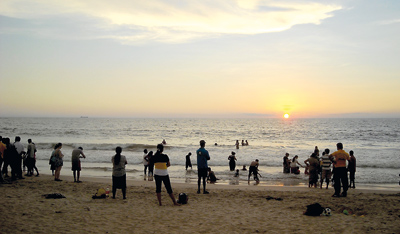The unscripted beach
Udan Fernando considers Mount Lavinia beach an extension of his backyard – albeit a very crowded one. ‘It’s my place to walk, exercise, eat, drink, relax, host friends and ‘just be’!’ writes Udan, noting that he is not the only one. The generosity with which the beach welcomes hundreds of people every day is what he and his research partner Debra Efroymson most value about it. Rugby players pause their games to allow ‘umbrella’ lovers to walk by, dogs and their owners mingle along the edge of the surf, fishermen pull in their nets with the help of the odd tourist, families walk up from nearby houses or take the bus from far away, posh eateries and simple vendors do brisk business side by side. Governed spontaneously by those who use it, people of all ages, genders and social contexts feel at home on Mount Lavinia beach – here is a public space in the truest sense.
Their shared love for it led Udan and Debra to consider a case study with the beach as its focus. With the help of eight students from the University of Moratuwa, they studied it exhaustively – noting its demographic and the uses it was put to, who did what, which part of the beach they used and when. They asked 371 beach users question after question – How safe did they feel? What amenities were lacking? How clean was it? How often did they visit the beach and from where did they come? The researchers created bar graphs and tables, breaking it all down statistically, finding objective, factual evidence for what they already knew intuitively – that as a public space Mt. Lavinia beach was really a success story.Their findings are recorded in ‘Public Space and Quality of Life: A Case Study of Mount Lavinia Beach’, a report to be launched this week.
Explaining that she has always been interested in public spaces and how they contribute to wellbeing in cities, Debra writes: ‘in my travels I have seen more beautiful beaches, but I prefer Mount Lavinia Beach. It feels real…Mount Lavinia Beach is vibrant, with so much activity, so much life.” Debra, who has an MSc from the Harvard Schoolof Public Health in Population and International Health, is the author of multiple books and reports including ‘Public Spaces, How they humanise cities’ and ‘Making Cities More Liveable’. Udan, who has a PhD in international development cooperation from the University of Amsterdam, is currently a Senior Professional at the Centre for Poverty Analysis in Colombo. Explaining that while they didn’t agree on everything Udan says he and Debra both “saw something beautiful, something magical at Mount Lavinia, especially compared to other public spaces.”
Debra, who is unwell, is unable to make our interview which is in close proximity to Independence Square. I ask Udan how he feels the two compare. He begins with a disclaimer: “I am not an expert on this at all,” says Udan. “I am a simple beach lover and user.” After hours spent on the beach, being what research terminology would dub a ‘participant observer’ Udan says it comes down to planned vs. unplanned, scripted vs. unscripted public spaces. He compares the relative freedom users of Mount Lavinia have with that of say the walking paths in Nugegoda where use is heavily regulated.
“The beauty in Mount Lavinia is that it is unscripted, and the second which is related is that it is self-organised but still there is coordination and harmony between diverse users engaged in diverse activities.”(He notes however that the work the Municipality does in cleaning up regularly, the lifeguard tower and the odd police patrol making the rounds are essential.) There is also the issue of ease of access and affordability to people from every socio-economic background – Mount Lavinia offers it, Independence Square does not.
“For us it shows us that it is an inclusive place, certain other places by virtue of how they are designed can become biased to a certain group of people. They become exclusive. At Mount Lavinia, I would say exclusivity is nil and that is something wonderful and rare.” He feels this all comes together in a very easy tolerance and social diversity: “You’ll see a Muslim woman coming in with an abhaya and 10 metres away is a foreigner lying there in her bikini and nobody is bothered. People just keep going.”

Pix by Udan Fernando and Debra Efroymson
However, the beach is not without its drawbacks. Users have said the absence of drinking water, public toilets and changing rooms were a downside to their beach experience. “These are basic amenities that are needed,” says Udan, adding that people also still need to embrace better beach etiquette – littering is distressingly common for example.
Going forward, as so many parts of the country are undergoing aggressive beautification programmes, what do Udan and Debra believe policy makers can learn from their case study? Accessibility and affordability appear to be key; the rest just takes care of itself. “Mount Lavinia is a best practice,” says Udan. “It would be great if policy makers would look at places that are organically public spaces rather than trying to engineer excessively.”
Public space: Mount Lavinia Beach
Public Space and Quality of Life: A Case Study of Mount Lavinia Beach will be launched on July 30 at 4.30 p.m. with a discussion chaired by Prof. Carlo Fonseka with a panel consisting Dr. Jagath Munasinghe, Head, Department of Town and Country Planning, University of Moratuwa, Ms.Sunela Jayawardene, Environmental Designer and Eng. Rohan Seneviratne, Additional Secretary (Technical), Urban Development Authority (UDA) and Project Director, Metro Colombo Urban Development Project. The event will take place at the Hector Kobbekaduwa Agrarian Research and Training Institute on 114, Wijerama Mawatha, Colombo 7. Call 0779832281 for more information.
Follow @timesonlinelk
comments powered by Disqus


